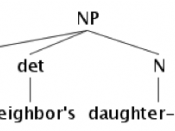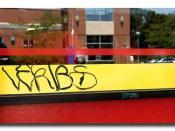HEAD the element of any construction that must be present in order for the element to occur: Noun in Noun Phrases [NP], Verb in Verb Phrases [VP], Adjective in Adjective Phrases [AP], Adverb in Adverb Phrases [AVP], Preposition in Prepositional Phrases [PP].
*head can be ellipted (left out), but it's reference will normally be recoverable from context.
* determine what other elements can co-occur in the phrase in terms of class, function/role and features
SPECIFIER
*Specifies the head element
*"outermost" or "leftmost" structural position to which an argument or other element can be assigned
*determiner in NP, subject in clause, degree words in adjective and adverb phrases function as specifiers for their respective phrase classes
SUBJECT: an element of clause structure.
Class: Subject is typically a Noun Phrase (NP) as in 1-3 but may also be a clause as in 4-6.
Subject Predicate
1. The tall man frightened them
2. The children ran away
3. They hid in the forest.
4. What they saw frightened them.
5. That he was dangerous seems unlikely.
6. Whether they will accept that is another matter
Agreement
*In finite present tense clauses the noun will agree with the verb in person and number and will be nominative (or possessive) case: He is sick, They are sick, Ours is/are all better but not *He are sick, *Them is sick. Note that clauses as subjects act like singular nouns in that they take singular verb agreement.
*Subjects in non-finite clauses are accusative (or possessive) case (where this is observable): We persuaded [them to leave]; She watched [him being silly]; Ours being first, we celebrated.
Order
In statements, the unmarked ('normal') position for subject is before all verbs. Mary is answering the question, The scientists might have been misled.
1. In questions, the subject follows the first...


